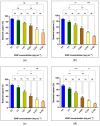Magnetite-Assisted Capture Affinity, Concentration Dependence, and Magnetic Extraction Rate of Bacillus cereus
- PMID: 40572064
- PMCID: PMC12195268
- DOI: 10.3390/microorganisms13061176
Magnetite-Assisted Capture Affinity, Concentration Dependence, and Magnetic Extraction Rate of Bacillus cereus
Abstract
The interactions between magnetic nanoparticles (MNP) and bio-surfaces have impacted key industries such as food, biomedicine, water purification, and agriculture. Bacteria, with their diverse bio-surfaces, offer potential for such interactions. Yet, there is a paucity of research interpreting the dynamics behind bacteria-nanoparticle interactions. Advancing this knowledge could improve the industrial applications. Current research gaps include information about the magnetic nanoparticle-assisted concentration dependence of Bacillus cereus and determination of the rate of bacterial extraction by MNPs such as iron oxide nanoparticles (IONPs). Using magnetic IONPs as the choice of MNP, this study aimed to investigate in vitro the interactions between model bacteria and IONPs, leveraging the bacterial magnetising property. IONPs were synthesised by co-precipitation and characterised. Magnetic capture efficiency was reported for four model bacteria (Bacillus cereus, Escherichia coli, Staphylococcus aureus, and Salmonella typhimurium). The effect of particle concentration on the viability of Bacillus cereus and the rate of magnetic extraction of Bacillus cereus were evaluated. Bacillus cereus had the most robust interaction with IONP (90.34%). While the magnetic extraction was time-dependent, the average rate of magnetic extraction for Bacillus cereus was calculated as 3.617 CFU mL-1/min. Growth inhibition at 1.0, 2.0, and 4.0 mg mL-1 of IONP was significant. Magnetic capture results indicated that members of the Bacillus genus screened for plant growth-promoting traits may be suitable to combine with IONPs for future land application.
Keywords: Bacillus; bacterial capture; bacterial viability; interactions; iron oxide; nanoparticle.
Conflict of interest statement
The authors declare no conflicts of interest.
Figures






Similar articles
-
Interventions for interpersonal communication about end of life care between health practitioners and affected people.Cochrane Database Syst Rev. 2022 Jul 8;7(7):CD013116. doi: 10.1002/14651858.CD013116.pub2. Cochrane Database Syst Rev. 2022. PMID: 35802350 Free PMC article.
-
Signs and symptoms to determine if a patient presenting in primary care or hospital outpatient settings has COVID-19.Cochrane Database Syst Rev. 2022 May 20;5(5):CD013665. doi: 10.1002/14651858.CD013665.pub3. Cochrane Database Syst Rev. 2022. PMID: 35593186 Free PMC article.
-
Intravenous magnesium sulphate and sotalol for prevention of atrial fibrillation after coronary artery bypass surgery: a systematic review and economic evaluation.Health Technol Assess. 2008 Jun;12(28):iii-iv, ix-95. doi: 10.3310/hta12280. Health Technol Assess. 2008. PMID: 18547499
-
Home treatment for mental health problems: a systematic review.Health Technol Assess. 2001;5(15):1-139. doi: 10.3310/hta5150. Health Technol Assess. 2001. PMID: 11532236
-
Eliciting adverse effects data from participants in clinical trials.Cochrane Database Syst Rev. 2018 Jan 16;1(1):MR000039. doi: 10.1002/14651858.MR000039.pub2. Cochrane Database Syst Rev. 2018. PMID: 29372930 Free PMC article.
References
-
- Chapa-González C., Sosa K.V., Roacho-Pérez J.A., García-Casillas P.E. Adsorption of Serum Protein in Chitosan-Coated and Polyethyleneimine-Coated Magnetite Nanoparticles. MRS Adv. 2021;6:913–917. doi: 10.1557/s43580-021-00153-7. - DOI
-
- Hashim A., Ibrahim H., Rashid F.L., Hadi A. Synthesis and Augmented Morphological and Optical Properties of Si3N4-TiN Inorganic Nanostructures Doped PVP for Promising Optoelectronics Applications. J. Inorg. Organomet. Polym. Mater. 2024;35:827–837. doi: 10.1007/s10904-024-03324-9. - DOI
Grants and funding
LinkOut - more resources
Full Text Sources

